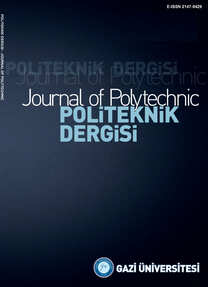Investigating Some Classification Methods To Evaluate Efficiency Results: A Case Study By Using Conjoint Analysis
Conjoint analysis, data envelopment analysis, linear discriminant analysis, binary logistic regression, artificial neural networks
Investigating Some Classification Methods To Evaluate Efficiency Results: A Case Study By Using Conjoint Analysis
Conjoint analysis, data envelopment analysis, linear discriminant analysis, binary logistic regression, artificial neural networks,
___
- [1] Chaney, P.K. and Devinney, T.M., “New product innovations and stock price performance”, Journal of Business, Finance and Accounting, 19: 677-695, (1992).
- [2] Tone, K., “A slacks-based measure of efficiency in data envelopment analysis”, European Journal of Operational Research, 130: 498-509, (2001).
- [3] Baker, N.R., Green, S.G., and Bean, A.S., “Why R&D projects succed or fail”, Research Management, 6: 29-34, (1986).
- [4] Crawford, C.M., “New product failure rates: a reprise”, Research Management, 30: 20-24, (1987).
- [5] Mishra, S., Kim, D. and Lee, D.H., “Factors affecting new product success: cross country comprisons”. Journal of Product Innovation Management, 13: 530-550, (1996).
- [6] Booz, Allen and Hamilton, “New product management for the 1980s”, New York: Booz Allen Hamilton Inc., Chapter 2, (1982).
- [7] Urban, G.L. and Hauser, J.R., “Design and Marketing of New Products”, 2nd Edition. Upper Saddle River, NJ:Prentice Hall, (1993).
- [8] Salhieh, S. M. and Al-Harris, M.Y. “New product concept selection: an integrated approach using data envelopment analysis (DEA) and conjoint analysis (CA)”, International Journal of Engineering and Technology, 3: 44–55, (2014).
- [9] Rao, V.R., “Applied Conjoint Analysis”, Springer Verlag Berlin Heidelberg, (2014).
- [10] Green, P.E., “On the design of choice experiments involving multifactor alternatives”. Journal of Consumer Research, 1: 61-68, (1974).
- [11] Leber, M., Bastic, M., Mavric, M. and Ivanisevic, A., “Value analysis as an integral part of new product development, Procedia Engineering, 69: 90-98, (2014).
- [12] Pelsmaeker, S.D., Schouteten, J.J., Lagast, S., Dewettinck, K. and Gellynck, X., “Is taste the key driver for consumer preference? A conjoint analysis study”, Food Quality and Preference, 62: 323-331, (2017).
- [13] Wu, W.Y. and Liao, Y.K., “Applying conjoint analysis to evaluate consumer preferences toward subcompact cars”, Expert Systems with Applications, 41: 2782-2792, (2014).
- [14] Niazi, A., Dai, J.S., Balabani, S. and Seneviratne, L., “Product cost estimation:Technique classification and methodology review. Journal of Manufacturing Science and Engineering, 128: 563-575, (2006).
- [15] Charnes, A., Cooper, W. and Rhodes, E., “Measuring the efficiency of decision making units”, European Journal of Operational Research, 2: 429-444, (1978).
- [16] Büschken, J., “How data envelopment analysis reveals brand advertising efficiency”, GFK Marketing Intelligence Review, 1: 36-45, (2009).
- [17] Donthu, N., Hershberger, E. and Osmonbekov, T., “Benchmarking marketing productivity using data envelopment analysis”, Journal of Business Reasearch, 58(11): 1474-1482, (2005).
- [18] Li, W.H., Liang, L. and Cook, W.D., “Measuring efficiency with products, by-products and parent offspring relations: A conditional two-stage DEA model”, Omega, 68: 95-104, (2017).
- [19] Duda, R.O., Hart, P.E. and Stork, D.G., Pattern Classification, Wiley InterScience, (2000).
- [20] McLachlan, G., “Discriminant Analysis and Statistical Pattern Recognition”, Wiley-InterScience, (2004).
- [21] Fisher, R.A., “The use of multiple measurements in taxonomic problems”, Annals of Human Genetics, 7: 179-188, (1936).
- [22] Shyu, J. C. and Liou, H. Y., “The financial distress prediction model under consideration of business cycle and industry factors – the application of logistic regression model and DEA-DA model. Journal of Risk Management, 12: 157-183, (2010).
- [23] Ting, H. M., Lee, T. F., Cho, M. Y., Chao, P. J., Chang, C. M., Chen, L. C. and Fang, F.M., “Comparison of neural network and logistic regression methods to predict xerostomia after radiotherapy”, International Journal of Biomedical and Biological Engineering, 7(7): (2013).
- [24] Sharma, P. and Kaur, M., “Classification in pattern recognition: a review”, International Journal of Advanced Research in Computer Science and Software Engineering, 3(4): (2013).
- [25] Erdoğan, C., “Tüketicinin Otomobil Tercihinin Konjoint analizi ile Belirlenmesi”, Graduate School of Natural and Applied Science, Department of Statistics, Gazi University, (2006).
- [26] Zhu, W., Zeng, N. and Wang, N., “Health Care and Life Sciences”, NESUG, (2010).
- [27] Wong, H. B. and Lim, G. H., “Measures of Diagnostic Accuracy: Sensitivity, Specificity, PPV and NPV”, Proceedings of Singapore Healthcare, 20(4): (2011).
- ISSN: 1302-0900
- Yayın Aralığı: 6
- Başlangıç: 1998
- Yayıncı: GAZİ ÜNİVERSİTESİ
EZGİ NAZMAN, Hülya OLMUŞ, Semra ERBAŞ
Support Vector Machine Based Spam SMS Detection
Musa BİLGİN, Şener KARABULUT, AHMET ÖZDEMİR
Gri Tahmin Yöntemi İle İstanbul Su Tüketiminin Modellenmesi
Eyyüp Ensar BAŞAKIN, Mehmet ÖZGER, Necati Erdem ÜNAL
Özge BAYRAKLI SÜRÜCÜ, HASAN HÜSEYİN GÜLLÜ
Dilimlenmiş Elma ve Havucun Isı Pompası Tekniği ile Kurutulması: Performans Analizi
Mustafa AKTAŞ, MELTEM KOŞAN, Cem ÇATALBAŞ, Mert GÖK
Mesut TEKKALMAZ, Gökhan HAYDARLAR, MEHMET ALPER SOFUOĞLU
Mehmet Serkan YILDIRIM, Yakup KAYA, Ramazan ÇAKIROĞLU, Behçet GÜLENÇ, Nizamettin KAHRAMAN, Ahmet DURGUTLU
Ti6Al4V Titanyum Alaşımının Delinmesinde Delme Yönteminin Aşınmaya Etkisinin İncelenmesi
